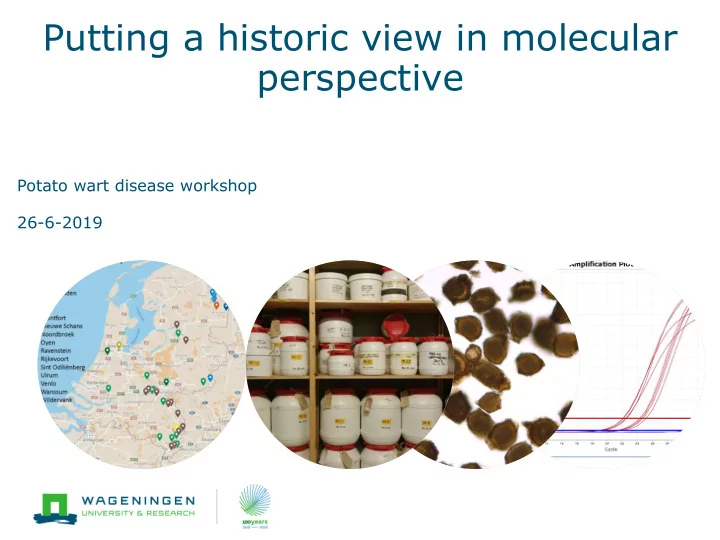

Putting a historic view in molecular perspective Potato wart disease workshop 26-6-2019
Presentation outline ▪ Spread of potato wart disease in the last century ▪ Putting the historical collection to use ▪ Towards molecular characterization of the Dutch isolates ▪ Optimization of zonal centrifuge for the extraction of spores from soils and composts ▪ DNA/RNA extraction and quality control ▪ Sequencing and haplotyping 2
Potato wart disease was first found in 1915 Stichting Oud-Winschoten , ‘t Zandpad ~1930 ▪ Found in Winschoten (Groningen) in a private garden on “‘t Zandpad ” ▪ Found by Mr. Uil who was a teacher at an agricultural school ▪ Poverty-stricken part of town: home-grown food for own use 3
Timelapse 1915 - 1927 4
Rapid spread in 1926 – 1927 along the course of the river Meuse following massive floods Beneden Leeuwen 1926 Gennep 1926 Tegelen 1926 5 Roermond 1926
First outbreaks vs current risk zones Current zones of increased vigilance are shown in red 6
Brief period of absence and rediscovery ▪ Strict phytosanitary measures led to a brief reported absence of the pathogen in 1970 ▪ Re-discovery of the pathogen in 1973 in the north of the Netherlands ● Before this was pathotype 1(D1), new findings were 2(G1) ▪ In 1990, pathotype 6(O1) was reported from north-east Netherlands ▪ In 2001, pathotype 18(T1) was reported from N-E Netherlands ▪ In 1990 also rediscovery of the pathogen in south-east Netherlands ● In contrast to northern provinces, only pathotype 1(D1) was found 7
Compost collection at NVWA 8
Collection (183 pot ID) on tour 9
Hendrickx zonal centrifuge at PPO-AGV 15.000 x g Schematic side view of the Hendrickx centrifuge in operation. 1: separation fluid (CaCl 2 1.4 SD ), 2: water, 3: soil suspension, 4: kaolin suspension, 5: overflow A: sediment from soil, B: kaolin, C: CaCl 2 , D: fluid with sporangia, E: water, F: hollow drive tube, G: bottle with supernatant 10
Optimization of ZC method 11
Washing & concentrating fluid with sporangia Filter funnel combined with nylon net Yield of spores on 20 um Nylon net filter 12
Differences in yield due to different composts Pot ID 100 Larger pieces after ZC Wart material containing ws 13
Remarkable things Pot ID 83 and 96 extra sieving 40uM Spore suspension is very difficult to filtrate through 20uM nylon sieve Many ws are encapsulated In starch? 14
After ZC nicely cleaned up WS 15
Preparing for nucleic acid extraction ▪ Total of 183 pot ID ▪ Oldest is from the 80s ▪ At least 83 pot ID registered as NL ▪ 11 pot ID < 100 gr compost ▪ 54 pot ID too low yield of ws 16
DNA-RNA extraction (cat no 80204) 17
DNA-RNA extraction (cat no 80244) 18
Molecular assays 19
Comparison kits: DNA samples (60ul) AllPrep power fecal Avg Ct = 22.31 Sendo Avg Ct = 32.83 COX dCt = 10.52 Sendo COX AllPrep Avg Ct = 24.69 Sendo Avg Ct = 31.74 COX dCt = 7.05 20
Results of 203 composts in TaqMan assays using MB42 DNA as standard curve COX Sendo Pot ID 1 - 104 Pot ID Sendo COX 105 - 203 21
Selected isolates for sequencing potID 1 9 17 25 42 49 57 73 81 89 97 2 10 18 27 43 50 65 74 82 90 98 3 11 19 28 47 51 68 75 83 91 99 4 12 20 31 MQ 52 69 76 86 92 100 5 13 21 32 MQ 53 71 77 88 93 101 6 14 22 34 MQ 54 72 78 MQ 94 102 7 15 23 37 MQ 55 MQ 79 MQ 95 104 8 16 24 38 MQ 56 MQ 80 MQ 96 MB42 ng/ul 0.4 0.1 0.2 0.3 0.1 0.4 1.4 0.6 0.2 0.5 0.2 0.1 0.2 0.3 0.1 0.1 0.2 0.6 0.4 0.4 1.1 0.5 0.4 0.1 0.3 0.4 0.1 0.2 0.3 0.2 0.2 0.5 0.8 0.1 0.1 0.3 0.6 0.1 0.3 0.3 0.1 1.3 0.2 0.6 0.1 0.1 0.4 0.1 0.1 0.3 0.3 0.7 0.1 0.2 0.6 0.1 0.1 0.1 0.1 0.1 0.3 0.2 0.2 0.1 0.3 0.1 0.1 0.1 0.2 0.2 0.1 0.6 0.1 0.2 0.1 0.3 1.2 0.1 0.2 0.2 0.2 0.1 0.1 0.1 1.3 0.1 0.5 1.2 Picogreen measurement: Very low DNA concentration 22
Different mitochondrial lineages? 23
Use of historical collection ▪ 183 pot ID (isolates) ▪ Many of them are not viable ▪ Volume reduction by storing collected ws dry ▪ 129 isolates DNA/RNA extracted ▪ 118 are of enough quality ▪ Sequencing ▪ Hope to build a new network and understand the spread and epidemiology 24
Co-operation ▪ Wageningen UR, Biointeractions and Plant Health ● Marga van Gent-Pelzer ● Theo van der Lee ▪ Dutch National Plant Protection Organization ● Bart van de Vossenberg ● Patricia van Rijswick ● Gerard van Leeuwen ▪ Wageningen UR, Field Crops ● Olaf Hartsema ● Andre Ramaker 25
Recommend
More recommend